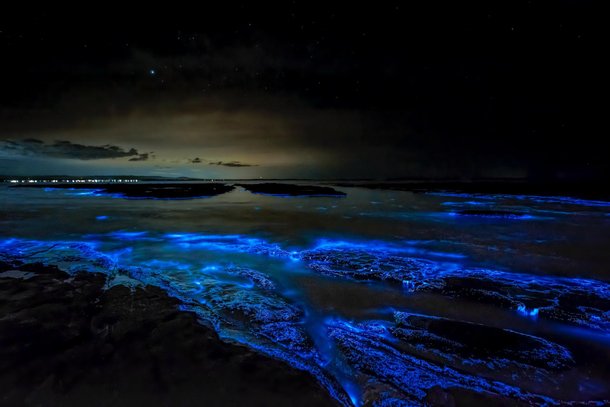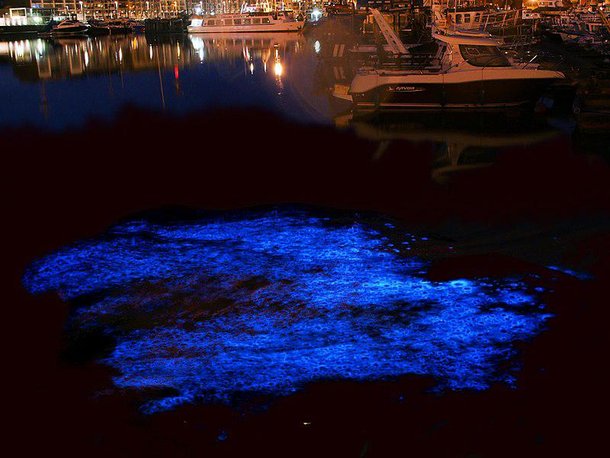Um universo de beleza e encanto. É assim que podemos descrever nossos mares e oceanos, lar das mais variadas formas de vida. Hoje já temos um maior conhecimento sobre a sua extensão e importância para o planeta, mas a superfície marinha permanece abrigando alguns mistérios que não foram totalmente decifrados.
Um deles diz respeito aos mares leitosos, um fenômeno que encanta viajantes, amantes do mar e estudiosos. O inconfundível tom de azul das águas, que para o olho humano é visto como um branco translúcido, tem sido observado há séculos. Ao longo do período, muitos registros foram feitos por marinheiros, mas apenas nos últimos anos foi possível entender do que realmente se trata.
 A bioluminescência presente no ambiente marinho é conhecida há séculos, mas ainda hoje surpreende observadores. (Fonte: Unsplash)
A bioluminescência presente no ambiente marinho é conhecida há séculos, mas ainda hoje surpreende observadores. (Fonte: Unsplash)
Relatos ao longo da história
Uma das descrições mais famosas sobre o evento foi feita por Charles Darwin, autor de A Origem das Espécies, em sua viagem à América do Sul, iniciada em 1831. Na literatura, relatos semelhantes também ficaram presentes tanto em Moby Dick (1851), de Herman Melville, quanto na obra Vinte Mil Léguas Submarinas (1869), de Júlio Verne.
E todos esses registros eram unânimes: não se tratava de um brilho qualquer. Para quem está no mar, todo o horizonte se ilumina, tornando impossível não reparar. Já o local das ocorrências variava, ando, por exemplo, pela Ilha de Java e na costa da Somália, litoral africano. Apenas em 2005 foi possível obter imagens mais nítidas das águas pela primeira vez e compará-las com as observações realizadas em um navio.
 Visão de satélite dos mares leitosos. (Fonte: Wikimedia)
Visão de satélite dos mares leitosos. (Fonte: Wikimedia)
Seres luminosos
A princípio, os estudiosos acreditavam que os dinoflagelados seriam os responsáveis por emitir o brilho, sendo uma forma de reagir às perturbações no mar, seja pelo efeito da quebra das ondas ou por outras causas externas. Mas como essa espécie produz um brilho de curto alcance e duração, esta hipótese acabou sendo descartada. A percepção que os mares leitosos estão presentes em áreas mais calmas do oceano também contribuiu para isso.
Mais adiante, a análise das águas apontou a presença da bactéria V. harveyi e da microalga Phaocystis, explicando o motivo do brilho intenso: as bactérias colonizavam as algas e tinham na emissão da luz uma forma eficiente de atraírem os peixes, pois é no intestino destes animais em que os micro-organismos encontram seu habitat ideal.
 Apesar do brilho intenso, é durante a noite que o efeito mais chama a atenção. (Fonte: Wikimedia)
Apesar do brilho intenso, é durante a noite que o efeito mais chama a atenção. (Fonte: Wikimedia)
Estudo trouxe dados importantes
Na pesquisa conduzida por Steven D. Miller, professor de ciência atmosférica, os registros mostraram que o alcance desse evento abrangia uma imensa área da água do mar, podendo se estender numa faixa de até 100.000 km². O estudo, realizado entre 2012 e 2021 e publicado na Nature Scientific Reports também concluiu que as bactérias só brilhavam com maior intensidade quando concentradas em um grande volume.
Além disso, a investigação possibilitou observar casos em que as águas ficaram iluminadas por dias e mesmo semanas. Apesar de expressivo, o fenômeno dos mares leitosos é raro, ocorrendo apenas três vezes por ano e com maior recorrência no Oceano Índico – o que pode justificar a dificuldade para conseguir imagens e mais informações.
E se o trabalho dos pesquisadores permitiu obter avanços significativos, ainda não significa que todas as perguntas tenham sido respondidas. Hoje, o entendimento é que ainda é necessário conhecer mais a fundo a ação destes seres, mas o estudo deu um o importante para nos ajudar a compreender um pouco mais sobre a vida marinha.
Fonte: Mega Curioso.
